
|
About OgreCave and its staff
|

|
by Mike Sugarbaker
Vortex was designed by Christian Petersen and Tom Jolly, the same team that did Diskwars, along with FFGer Darrell Hardy, who contributed to Diskwars expansions and the great Doomtown Range Wars. Now, you've had Vortex's Diskwars lineage beaten into your head already if you've been reading OgreCave for a while. Diskwars was as great on a high-concept level (2D collectible skirmish minis, years before Mage Knight) as it was on the micro level of actual game mechanics, and I was hoping from the first announcement to get something of equal genius out of Vortex. Well, Vortex isn't quite the first game to make it to market that weds Magic-like game mechanics to a positional strategy game played on a hex grid - see also Sack Armies - but it is the best one. But when you play a collectible game, you can't ever just play the game; you have all these other problems to contend with, and in Vortex's case they are problems indeed. It's worth exploring these, both in order to learn how we might get the most out of it, and out of any collectible game that suffers because of how it's sold, not how it plays.
So How Does It Play? Notice that that happens at the end of your turn. Tempo in Vortex is one of the most satisfying aspects of playing the game. You always get a complete opportunity to respond to your opponent's moves and get a handle on your fate. Always. More on this when we talk more about the positional game, but let's finish running down the basics. First you move. All movement of minions you control happens at the beginning of your turn. All movement takes place along the outer edge of what's called "the Vortex mass," meaning the whole collection of game tiles that have glommed onto the central Vortex tile. You don't get to move through other tiles (unless you have flying), which for Magic fans means that creatures can be blockers in a whole new sense. Putting your toss-off cheap creature in between your opponent's big tough guy and the thing he wants to kill can buy you an entire turn, just by virtue of the baddie having to take two or three extra steps. This makes flying a very powerful ability, almost to the point where it unbalances the game, but we'll get into that. Then you take three actions. An action can be an attack, a card draw (sorry, a tile draw - incidentally, taking an action to draw or using some special effect are the only ways to get tiles into your hand), or "consuming an energy tile." Attacks are straightforward: apply the attack, apply the defense right back, take a wound if you had enough damage done to you, die if you had enough wounds done to you. When tiles die, though, they aren't removed from the board. They get flipped over and are considered to be "energy tiles," which remain on the board, sitting rudely in that spot where you need to put a stronghold, until someone takes an action to consume it. ("Kill all you want, but eat all you kill.") Consuming an energy tile gets you an Energy token, which can be spent on extra actions, augmenting the output of your strongholds (yeah, I'm getting to that too), and sundry special effects and event tiles. Lastly, after you're done raising hell for the turn, you summon. Each of your strongholds, the land-like stuff, has Output. To bring in a minion with a cost of 2 Output, for example, you have to summon it in a spot adjacent to two strongholds each with one Output, or to one stronghold with an Output of two or more. Some strongholds have a cost themselves, but the basic ones are free - they're just designated Limited, so you may only summon one of them per turn. Each faction in the game has a different color Output which its minions generally require, and they can't share. After summoning, you check to see if you have fewer tiles adjacent to the Vortex than your opponent, and if you do, you lose precious bodily fluids.
On The Board
Well-placed summonings can "pin" one or more of your opponent's tiles, because no one can ever make a move that disconnects anything from the main mass. The only way to get a new minion into enemy territory fast is to drop in a Limited stronghold, but what if you need it later to plug a hole next to the Vortex? There is a tremendous amount going on in this game, with the hex grid, plus special abilities on the board, plus card-drawing and card-playing decisions. Another way Vortex uses the board lies in special abilities: many of them are keyed to location and adjacency. Some minions get bonuses for being adjacent to the Vortex, which can be interesting if you start the game with them and defend them well. Others get a +1 for each adjacent neighbor of a certain kind, which is fun but can be hard to maintain when your forces are called for in many different directions. It can also be frustrating to read special abilities keyed to tiles that have some tag or attribute that you not only haven't drawn yet, but is so obscure that you've never seen it in a booster. Which leads me to...
Collectibility, or: Things That Suck Vortex tiles come in eight factions. "Eight?" you say. "But I only see four different kinds of starter sets on the shelf." That's right, Sparky. The Host (angelic types), the Brood (demonic types), the Draconis (take a guess), and the Arcanae (bookish city types with castles and stuff) are the starters, and in that pack you'll get four flats of three tiles each that are fixed and give you a solid base in that faction. The other four flats in the starter are essentially a free booster: three common flats of three tiles, and one rare flat of three. There are four other factions in the game: Loftis (neat Victorian air-pirates kind of deal), Necris (vampires et cetera), Gaians (careful how you pronounce that), and the Deep (evil undersea types). The Necris and the Gaians look like they could be pretty powerful, but I can't tell you for sure, because after considerable investment in the game (see above), I still don't have enough tiles in those factions to make a playable stack. Either I have plenty of minions but no land, or vice versa. This is annoying, especially when a closed set of playtesters could have spotted it so easily. They could have reduced it to six factions and done fine. However, it's also easily solved by forming a play group and doing some trading, or trading online or what have you. This is the same sort of problem NetRunner and Star Wars had: you play either the Runner or the Corp, but the booster gives you both, whether or not you want them... and the rare card is going to be one or the other. Place your bets. No refunds. It's not as if it's practical to make eight different kinds of boosters, but still. The next problem is a little tougher, and familiar to any player who's tried enough new CCGs in the last few years. When I say "unbalanced factions," I basically mean this: THE HOST OWNS. Even when I play it. I have yet to see it lose in a two-player game. It has so many damn flyers, and undercosted power players like Eternal Brood (3 Output for a first-strike 3-strength, 2-movement flyer), that it just tends to get a lot of momentum and keep it. They clearly tried to give each faction a different tendency and make the interactions interesting, but the common themes in special abilities and powers seem sort of ineffectual a lot of the time. It's difficult to get all your units arranged to build a strong chain of bonuses with those "+1 to adjacent _____" types of tiles, and units die so fast and come back in so slowly that you're never going to have a fabulous array of the attribute you need for those "all your ____s get ____" things (not in a stack of the average size of 20 to 25, anyway). The weaknesses of some of the lesser factions can probably be overcome through careful deck-building, which is at least possible in the four factions that come in starters. But when one faction doesn't even need tuning, where are you? Again, this problem can be fixed by a conscientious play group that makes league-wide decisions about what to play and how, specific tiles to ban, whatever. And maybe we just haven't found the magic bullet (or tile) that solves the particular problem of the Host, and it's obvious to everyone else.
If you play lots of CCGs, you get used to coercive restrictions like these, but they have to make sense. If FFG is so worried that Good-against-Good games will break somehow, or that decks that mix Good and Evil tiles will be too powerful, why not just balance the factions? If they're worried that letting anyone play anyone will get too convoluted, why not make fewer factions? I wouldn't suggest that they created the Good-against-Evil-only restriction to save themselves some testing time, but you can certainly see how the business considerations of a collectible game can sometimes mess with the important technical decisions. And there's a fourth problem: price. This is inescapable and it's the reason a lot of gamers stay away from collectible games altogether, especially in this day and age. A lot of gamers are geeks, a lot of geeks are out of work, and FFG released a collectible game with five-dollar, twelve-card boosters in which each trio of cards always comes together. Is it any wonder they needed to have a fire sale? But there's a great game in there. That's why collectibility can be so frustrating. As of this writing, the fire sale is still on, and OgreCave hereby reccomends you take advantage. For an investment of $40, you can have more tiles than I do (impressive). We recommend you buy only half as many starters, rounded up, as you expect to have players. You don't need all the extra counters and basic units the starters will give you. Double up on boosters instead. (The best starters to get? Host and Arcanae.) Once you have all those tiles, we'll even tell you exactly what to do with them, and how to make any collectible game better, in case you've forgotten.
How To Make Vortex The Great Game It Really Is
Third: play multiplayer. We have to admit that we have been too caught up in two-player combos to test three- or four-player games. But we have every reason to expect they will be super-convoluted and screamingly fun. But two-player's pretty good too. Hint: for four-player games, put two Vortex tiles next to each other to start, so there are a total of eight adjacent-to-Vortex positions and nobody gets inherently screwed in the first round. Four: take the task of game-building seriously. Players who talk about the game and agree to make collective decisions that make the game suck less as a whole, and stick to them, are the kind of people you should be playing with anyway. You can apply all of these guidelines to any game hampered only by its collectibility. People are so often willing to kick in money for their own copies of the RPG books for the game they play, or be the one guy who buys the book and then shares it with the GM - but people haven't thought to apply similar communist models to CCGs, because CCGs lock you in such a competitive, possessive mindset. If you've found the seed of a game you love inside of all that random crap, work with friends on creative solutions. Thank you. I'll be in the bar.
The Bottom Line Gamers who scoff at anything collectible are missing some great games. Those of us who've been "recreational users," or perhaps even "serial abusers" of CCGs for the past few years of post-Magic hangover can attest to this. It isn't easy to find the good ones even in the relative paucity of today's market, but that's what reviews are for, right? So crash the Vortex party already. It's so crowded with factions that no one will probably notice.
|
||
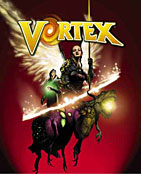 Vortex, like many collectible games gone before it, is a great game trapped in a bad situation. I won't bore you by getting too deep into a rant about NetRunner, the great, misunderstood game of yore, dazzling in its ingenuity and balance, killed by decisions of packaging and printing. More recently, Allan and I have been picking over the remains of Doomtown, which had trouble from the get-go due to problems of narrative pacing (failure to hit 'em with zombies soon enough). When did games ever have problems like that before CCGs came around? I mean, games have always been able to die due to bad business decisions, but they haven't been able to suffer before they die, the way they have since Magic. I guess you could say that RPGs can always die due to mismanagement of the flow of support products, but you can go on playing an RPG every week, even after it loses its whole support system. Good GMs can play without a support system at all. A group playing a dead CCG will suffocate for lack of new cards if they play too often. But now we're getting off track - let us shed one last tear for NetRunner and then move on.
Vortex, like many collectible games gone before it, is a great game trapped in a bad situation. I won't bore you by getting too deep into a rant about NetRunner, the great, misunderstood game of yore, dazzling in its ingenuity and balance, killed by decisions of packaging and printing. More recently, Allan and I have been picking over the remains of Doomtown, which had trouble from the get-go due to problems of narrative pacing (failure to hit 'em with zombies soon enough). When did games ever have problems like that before CCGs came around? I mean, games have always been able to die due to bad business decisions, but they haven't been able to suffer before they die, the way they have since Magic. I guess you could say that RPGs can always die due to mismanagement of the flow of support products, but you can go on playing an RPG every week, even after it loses its whole support system. Good GMs can play without a support system at all. A group playing a dead CCG will suffocate for lack of new cards if they play too often. But now we're getting off track - let us shed one last tear for NetRunner and then move on.
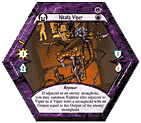 Vortex's basic mechanics won't come as a big shock to anyone who's played Magic, Diskwars, or both. There are four different types of hex tiles - Minions, Strongholds, Events, and Relics - that equate to creatures, lands, sorceries (sometimes instants) and enchantments in M:tG. Minions all have ratings for movement per turn, attack range (rarely more than 1 tile away), attack strength, armor (toughness) and life (wounds). Strongholds have no movement or attack, but do have armor and wounds - because everything is part of the positional game (except for events and relics), you can just wander over and attack your opponent's lands. That is in fact what you're going to spend most of your time trying to do, because if you have fewer tiles surrounding the Vortex tile than your opponent does at the end of your turn, you lose one of your three Essence counters. Lose them all and you're out of the game.
Vortex's basic mechanics won't come as a big shock to anyone who's played Magic, Diskwars, or both. There are four different types of hex tiles - Minions, Strongholds, Events, and Relics - that equate to creatures, lands, sorceries (sometimes instants) and enchantments in M:tG. Minions all have ratings for movement per turn, attack range (rarely more than 1 tile away), attack strength, armor (toughness) and life (wounds). Strongholds have no movement or attack, but do have armor and wounds - because everything is part of the positional game (except for events and relics), you can just wander over and attack your opponent's lands. That is in fact what you're going to spend most of your time trying to do, because if you have fewer tiles surrounding the Vortex tile than your opponent does at the end of your turn, you lose one of your three Essence counters. Lose them all and you're out of the game.
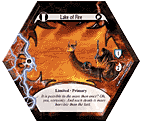 I won't spend too much more time comparing with Sack Armies, but generally Vortex has better art, more appealing story and factions, and the luck-free combat feels scads better. The SA mechanic involves flipping coins, and although it's more involved than just a flip, its linear nature doesn't make it feel much less random. Again, proving this calls for heavy statistical analysis than no one in their right mind wants to do, but it only takes one game of each to see my point.
I won't spend too much more time comparing with Sack Armies, but generally Vortex has better art, more appealing story and factions, and the luck-free combat feels scads better. The SA mechanic involves flipping coins, and although it's more involved than just a flip, its linear nature doesn't make it feel much less random. Again, proving this calls for heavy statistical analysis than no one in their right mind wants to do, but it only takes one game of each to see my point.
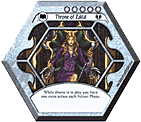 Finally, the rules put some restrictions about which factions can be played with which, and which factions can play against which. Some of the former are pretty sensible. For instance, the restrictions on Events and Relics, that you may only play them if you have in play a stronghold or minion of the same faction, ensures that events and relics add flavor to a particular faction and is totally appropriate. And of course, you can't put out a faction's minion unless you've got one of its strongholds out. (You can get around all that with certain special minions that aren't summoned conventionally - splash The Ascended into a deck and you can use any Host event you want.) But then it gets strange with the addition of Good and Evil factions. There are four of each in the game. According to the official rules, not only may you never mix Good and Evil tiles in the same deck (maybe there's a subtle reason for this relating to game balance that I'm not really seeing, but they're mostly getting away with this for story reasons, by which I mean, just because), but you may never play Good against Good or Evil against Evil in a two-player game. I'm glad they thought to specify "two-player game," thereby narrowly avoiding making multi-player games completely illegal, but still.
Finally, the rules put some restrictions about which factions can be played with which, and which factions can play against which. Some of the former are pretty sensible. For instance, the restrictions on Events and Relics, that you may only play them if you have in play a stronghold or minion of the same faction, ensures that events and relics add flavor to a particular faction and is totally appropriate. And of course, you can't put out a faction's minion unless you've got one of its strongholds out. (You can get around all that with certain special minions that aren't summoned conventionally - splash The Ascended into a deck and you can use any Host event you want.) But then it gets strange with the addition of Good and Evil factions. There are four of each in the game. According to the official rules, not only may you never mix Good and Evil tiles in the same deck (maybe there's a subtle reason for this relating to game balance that I'm not really seeing, but they're mostly getting away with this for story reasons, by which I mean, just because), but you may never play Good against Good or Evil against Evil in a two-player game. I'm glad they thought to specify "two-player game," thereby narrowly avoiding making multi-player games completely illegal, but still.
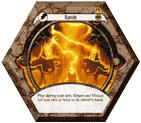 Second: ignore arbitrary restrictions, at least until you've tried playing without them. In Vortex, that means the like-alignments-may-not-fight rule. If they wanted a smaller combinatorial field than eight-times-eight, then - sing along, now - they should have made fewer factions. Host versus Arcanae is good fun and very nearly a good match for the Host. All of the Evil factions should naturally be smacking each other up all the time.
Second: ignore arbitrary restrictions, at least until you've tried playing without them. In Vortex, that means the like-alignments-may-not-fight rule. If they wanted a smaller combinatorial field than eight-times-eight, then - sing along, now - they should have made fewer factions. Host versus Arcanae is good fun and very nearly a good match for the Host. All of the Evil factions should naturally be smacking each other up all the time.